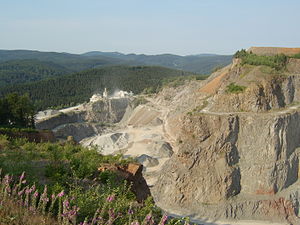Bilstein (Brilon Heights)
| Bilstein | ||
|---|---|---|
| height | 622 m above sea level NN (east summit) | |
| location | Hochsauerlandkreis , North Rhine-Westphalia , Germany | |
| Mountains | Northeastern Rothaargebirge | |
| Coordinates | 51 ° 22 '57 " N , 8 ° 37' 39" E | |
|
|
||
| particularities | Quarry | |
The Bilstein is a 622 m high mountain in the Brilon Heights in the middle east of North Rhine-Westphalia ( Germany ).
location
The mountain is located around 4 km east of Brilon on the southern edge of the Brilon Heights , the second highest point of which it represents. The Hoppecke flows at its feet , in the valley of which Brilon-Hoppecke lies southeast of the mountain.
Bilsteinwarte
In the course of a planned expansion of the quarry of DEUBA Baustoffe GmbH located on the Bilstein, an archaeological excavation was carried out by the excavation company Archbau on the summit of the Bilstein. When through the quarry owners as polluter -funded excavation of the tower stump highly preserved until 2.70 meters was a large pile of rubble the "Warth off Beilstein" exposed, a watch-tower , probably from the 14th to the early 15th century as part of Brilon Landwehr was built. The oldest written mention of the tower comes from around 1480. The approximately five meter diameter foundation plinth of the tower was sunk into the rock. The rising masonry of the actual tower body made of layered mortar rubble was still four meters in diameter. A special structural feature is a circumferential external staircase that was 0.6 meters wide attached to the side of the tower stump. Due to the size of the steps, the height of the stairs could be reconstructed to five meters. The entire watch tower will have been ten meters high. Slate fragments documented during the excavation in the medieval running horizon show that the roof of the tower was originally slated. The numerous finds made during the excavations included, for example, a mill set carved into a slate of slate and fragments of a clay horn ( aachhorn ). In order to enable the quarry to be expanded, this historic monument was destroyed despite numerous public protests. The stones have been cleared for further use by the city of Brilon.
Picture gallery
literature
- LWL Museum for Archeology : New Year's Greetings 2007. Münster 2007. P. 84.



